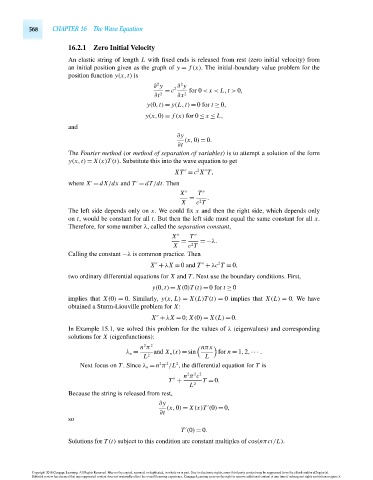Page 588 - Advanced_Engineering_Mathematics o'neil
P. 588
568 CHAPTER 16 The Wave Equation
16.2.1 Zero Initial Velocity
An elastic string of length L with fixed ends is released from rest (zero initial velocity) from
an initial position given as the graph of y = f (x). The initial-boundary value problem for the
position function y(x,t) is
2
2
∂ y ∂ y
= c 2 for 0 < x < L,t > 0,
∂t 2 ∂x 2
y(0,t) = y(L,t) = 0for t ≥ 0,
y(x,0) = f (x) for 0 ≤ x ≤ L,
and
∂y
(x,0) = 0.
∂t
The Fourier method (or method of separation of variables) is to attempt a solution of the form
y(x,t) = X(x)T (t). Substitute this into the wave equation to get
2
XT = c X T,
where X = dX/dx and T = dT/dt. Then
X T
= .
2
X c T
The left side depends only on x. We could fix x and then the right side, which depends only
on t, would be constant for all t. But then the left side must equal the same constant for all x.
Therefore, for some number λ, called the separation constant,
X T
= =−λ.
2
X c T
Calling the constant −λ is common practice. Then
2
X + λX = 0 and T + λc T = 0,
two ordinary differential equations for X and T . Next use the boundary conditions. First,
y(0,t) = X(0)T (t) = 0for t ≥ 0
implies that X(0) = 0. Similarly, y(x, L) = X(L)T (t) = 0 implies that X(L) = 0. We have
obtained a Sturm-Liouville problem for X:
X + λX = 0; X(0) = X(L) = 0.
In Example 15.1, we solved this problem for the values of λ (eigenvalues) and corresponding
solutions for X (eigenfunctions):
2
n π 2 nπx
λ n = and X n (x) = sin for n = 1,2,··· .
L 2 L
2
2
2
Next focus on T . Since λ n = n π /L , the differential equation for T is
2 2
2
n π c
T + T = 0.
L 2
Because the string is released from rest,
∂y
(x,0) = X(x)T (0) = 0,
∂t
so
T (0) = 0.
Solutions for T (t) subject to this condition are constant multiples of cos(nπct/L).
Copyright 2010 Cengage Learning. All Rights Reserved. May not be copied, scanned, or duplicated, in whole or in part. Due to electronic rights, some third party content may be suppressed from the eBook and/or eChapter(s).
Editorial review has deemed that any suppressed content does not materially affect the overall learning experience. Cengage Learning reserves the right to remove additional content at any time if subsequent rights restrictions require it.
October 14, 2010 15:23 THM/NEIL Page-568 27410_16_ch16_p563-610

